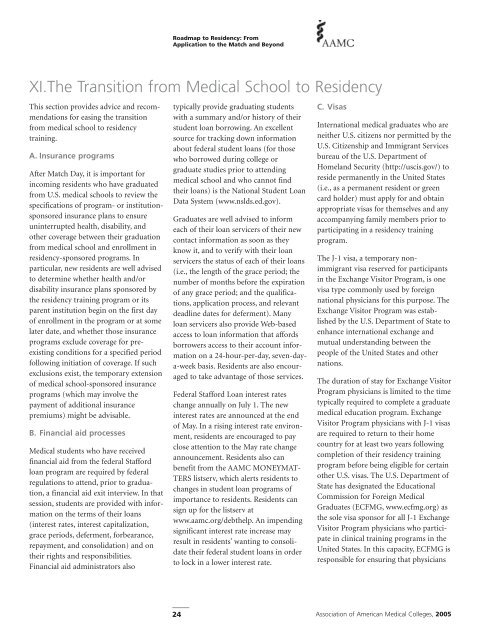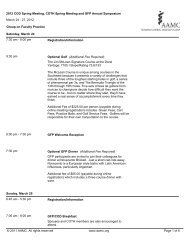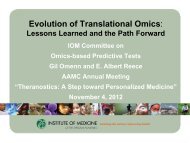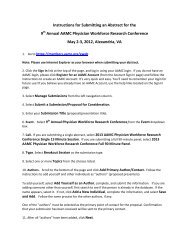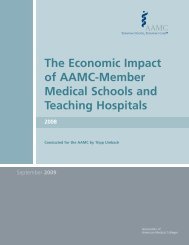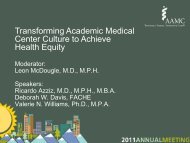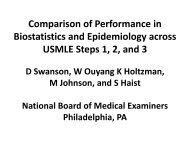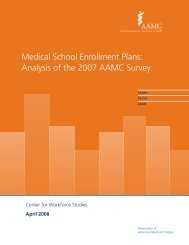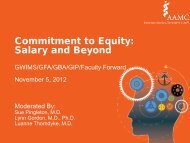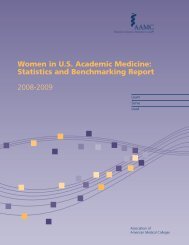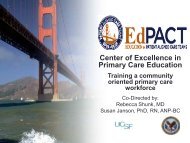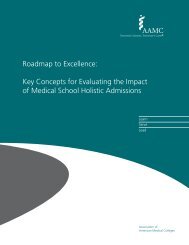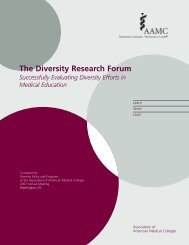Roadmap to Residency: - AAMC
Roadmap to Residency: - AAMC
Roadmap to Residency: - AAMC
You also want an ePaper? Increase the reach of your titles
YUMPU automatically turns print PDFs into web optimized ePapers that Google loves.
<strong>Roadmap</strong> <strong>to</strong> <strong>Residency</strong>: FromApplication <strong>to</strong> the Match and BeyondXI.The Transition from Medical School <strong>to</strong> <strong>Residency</strong>This section provides advice and recommendationsfor easing the transitionfrom medical school <strong>to</strong> residencytraining.A. Insurance programsAfter Match Day, it is important forincoming residents who have graduatedfrom U.S. medical schools <strong>to</strong> review thespecifications of program- or institutionsponsoredinsurance plans <strong>to</strong> ensureuninterrupted health, disability, andother coverage between their graduationfrom medical school and enrollment inresidency-sponsored programs. Inparticular, new residents are well advised<strong>to</strong> determine whether health and/ordisability insurance plans sponsored bythe residency training program or itsparent institution begin on the first dayof enrollment in the program or at somelater date, and whether those insuranceprograms exclude coverage for preexistingconditions for a specified periodfollowing initiation of coverage. If suchexclusions exist, the temporary extensionof medical school-sponsored insuranceprograms (which may involve thepayment of additional insurancepremiums) might be advisable.B. Financial aid processesMedical students who have receivedfinancial aid from the federal Staffordloan program are required by federalregulations <strong>to</strong> attend, prior <strong>to</strong> graduation,a financial aid exit interview. In thatsession, students are provided with informationon the terms of their loans(interest rates, interest capitalization,grace periods, deferment, forbearance,repayment, and consolidation) and ontheir rights and responsibilities.Financial aid administra<strong>to</strong>rs alsotypically provide graduating studentswith a summary and/or his<strong>to</strong>ry of theirstudent loan borrowing. An excellentsource for tracking down informationabout federal student loans (for thosewho borrowed during college orgraduate studies prior <strong>to</strong> attendingmedical school and who cannot findtheir loans) is the National Student LoanData System (www.nslds.ed.gov).Graduates are well advised <strong>to</strong> informeach of their loan servicers of their newcontact information as soon as theyknow it, and <strong>to</strong> verify with their loanservicers the status of each of their loans(i.e., the length of the grace period; thenumber of months before the expirationof any grace period; and the qualifications,application process, and relevantdeadline dates for deferment). Manyloan servicers also provide Web-basedaccess <strong>to</strong> loan information that affordsborrowers access <strong>to</strong> their account informationon a 24-hour-per-day, seven-daya-weekbasis. Residents are also encouraged<strong>to</strong> take advantage of those services.Federal Stafford Loan interest rateschange annually on July 1. The newinterest rates are announced at the endof May. In a rising interest rate environment,residents are encouraged <strong>to</strong> payclose attention <strong>to</strong> the May rate changeannouncement. Residents also canbenefit from the <strong>AAMC</strong> MONEYMAT-TERS listserv, which alerts residents <strong>to</strong>changes in student loan programs ofimportance <strong>to</strong> residents. Residents cansign up for the listserv atwww.aamc.org/debthelp. An impendingsignificant interest rate increase mayresult in residents’ wanting <strong>to</strong> consolidatetheir federal student loans in order<strong>to</strong> lock in a lower interest rate.C. VisasInternational medical graduates who areneither U.S. citizens nor permitted by theU.S. Citizenship and Immigrant Servicesbureau of the U.S. Department ofHomeland Security (http://uscis.gov/) <strong>to</strong>reside permanently in the United States(i.e., as a permanent resident or greencard holder) must apply for and obtainappropriate visas for themselves and anyaccompanying family members prior <strong>to</strong>participating in a residency trainingprogram.The J-1 visa, a temporary nonimmigrantvisa reserved for participantsin the Exchange Visi<strong>to</strong>r Program, is onevisa type commonly used by foreignnational physicians for this purpose. TheExchange Visi<strong>to</strong>r Program was establishedby the U.S. Department of State <strong>to</strong>enhance international exchange andmutual understanding between thepeople of the United States and othernations.The duration of stay for Exchange Visi<strong>to</strong>rProgram physicians is limited <strong>to</strong> the timetypically required <strong>to</strong> complete a graduatemedical education program. ExchangeVisi<strong>to</strong>r Program physicians with J-1 visasare required <strong>to</strong> return <strong>to</strong> their homecountry for at least two years followingcompletion of their residency trainingprogram before being eligible for certainother U.S. visas. The U.S. Department ofState has designated the EducationalCommission for Foreign MedicalGraduates (ECFMG, www.ecfmg.org) asthe sole visa sponsor for all J-1 ExchangeVisi<strong>to</strong>r Program physicians who participatein clinical training programs in theUnited States. In this capacity, ECFMG isresponsible for ensuring that physicians24Association of American Medical Colleges, 2005


